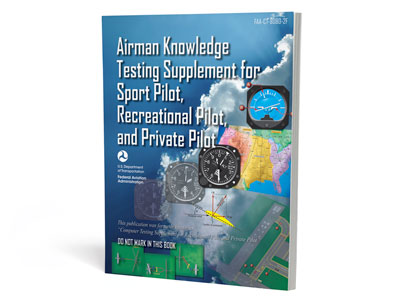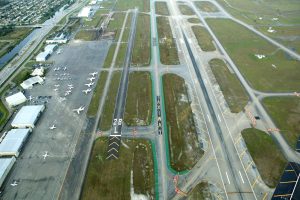Today I would like to discuss a specific figure in the Airman Knowledge Testing Supplement for Sport Pilot, Recreational Pilot, and Private Pilot (FAA-CT-8080-2F). If you are unfamiliar with this testing supplement it is a book of legends and figures of which some questions on the knowledge exam will refer to. You should become familiar with this publication as you will receive an identical copy to use on your FAA Knowledge Exam. You can find the supplement here.

Figure 65, “Airport Markings”, is shown below and depicts an overview of an airport layout with letters pointing to specific markings. A typical question you might encounter could read something like this:
(Refer to Figure 65.) Which symbol indicates a taxiway/taxiway intersection hold position marking?

In this question if you refer to the figure letter E represents a taxiway/taxiway intersection holding position marking. Let’s go through each letter A-F on the figure and determine what exactly it is pointing to.
A. Surface Painted Holding Position Sign. This type of sign is aligned left of the taxiway centerline and has a red background with white inscription. You will not see this sign at all airports as they are typically only on taxiways with a width greater than 200 feet.
B. Holding Position Markings for Instrument Landing System (ILS). This marking consists of two painted yellow lines spaced ten feet apart across the width of the taxiway. The two lines are connected by pairs of solid yellow lines. The marking depicts the ILS critical area, an area in which your aircraft could cause interference with the ILS equipment when in use.
C. Vehicle Roadway Marking. These markings are white and define a vehicle pathway in areas also intended for aircraft. Two styles are shown but both are essential identical in meaning. Vehicle pathways may often be referred to as the zipper road.
D. Runway Holding Position Marking. Bold yellow lines depicting the boundary of a particular runway. Two solid lines and two broken lines stretching the width of the taxiway or runway. When on the solid side of this marking, aircraft are required to hold short unless a clearance to cross or enter onto the runway has been received.
E. Holding Position Markings for Taxiway/Taxiway Intersection. A single yellow dashed line stretching the width of the taxiway. If instructed to do so by ATC aircraft should hold short so no part crosses this dashed line.
F. Taxiway Edge Marking. Two solid yellow lines denoting the edge of the taxiway. Separates the taxiway from a surface that is not intended for aircraft.
Additional info on Airport Markings can be found in Chapter 2 Section 3 of the Aeronautical Information Manual. The markings we have discussed above are just those shown in Figure 65—there are still many other markings that you should be aware of and understand.





